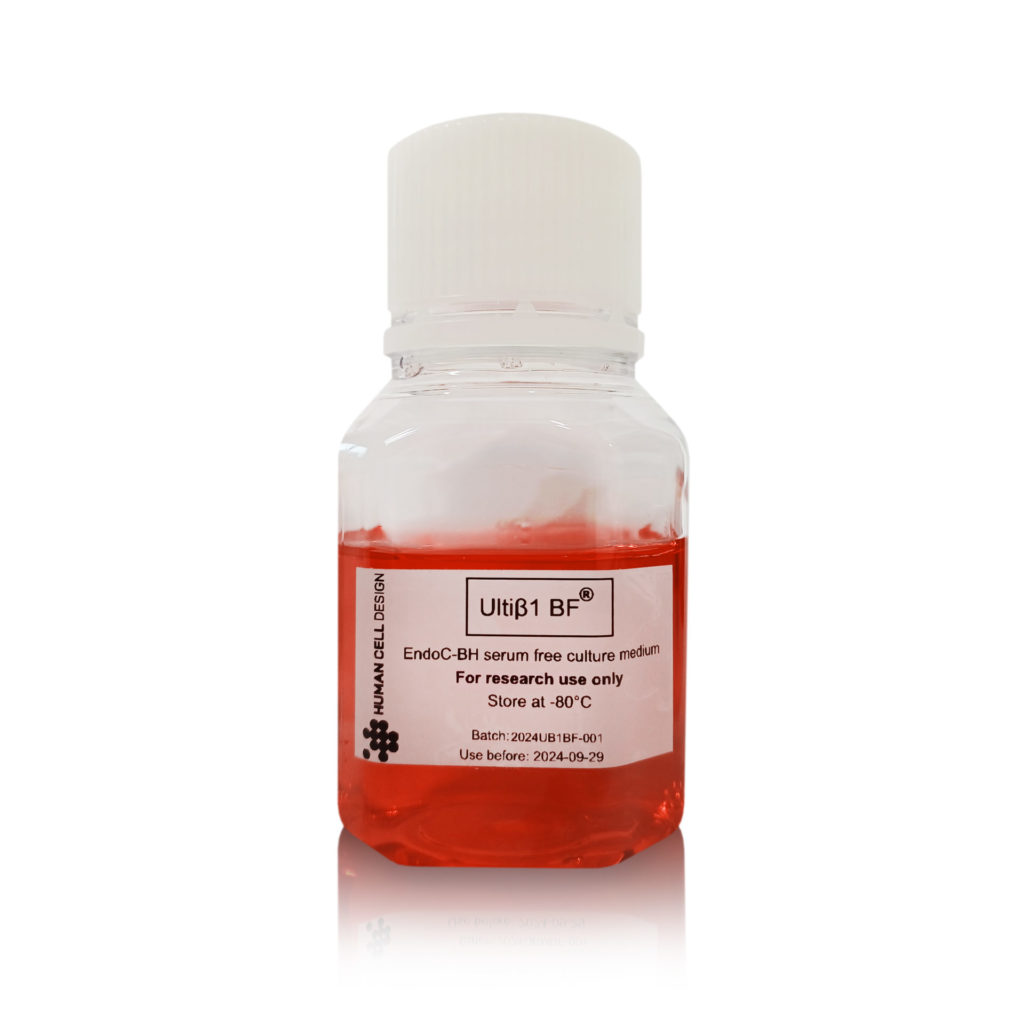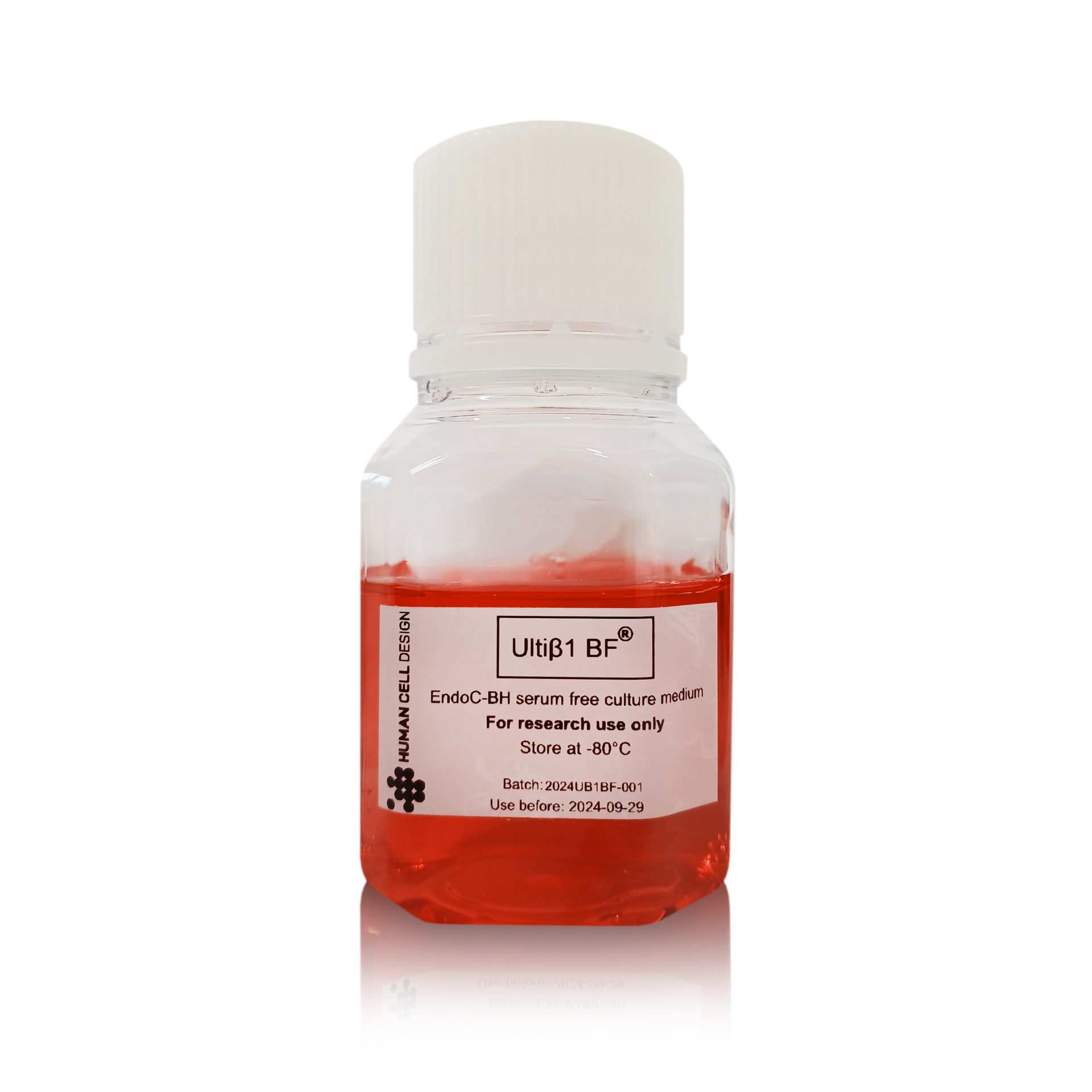
Ultiβ1-BF®
EndoC-βH5®, EndoC-βH3® and EndoC-βH1® Qualified Culture Medium
| Application | Catalog | Size |
|---|---|---|
| Culture of EndoC-βH5®, EndoC-βH3® and EndoC-βH1® cells | UB1-100-NO_BSA | 100mL |
Ultiβ1-BF®
EndoC-βH5®, EndoC-βH3® and EndoC-βH1® Qualified Culture Medium
| Application | Catalog | Size |
|---|---|---|
| Culture of EndoC-βH5®, EndoC-βH3® and EndoC-βH1® cells | UB1-100-NO_BSA | 100mL |
Product description
ULTIβ1-BF® medium is specifically designed for the culture of EndoC-βH5® EndoC-βH3® and EndoC-βH1® cells and the maintenance of their functional activity and beta cell identity and maturity. ULTIβ1-BF® medium is the BSA-free version of the original version of ULTIβ1® medium. ULTIβ1-BF® requires to be completed with 2% (w/v) of Fatty acid free fraction V bovine serum albumin (Fatty acid free BSA). For ULTIβ1-BF® medium reconstitution, please rigorously respects Fatty acid free BSA reference 10775835001 from Roche to obtain robust and validated results. ULTIβ1-BF® is chemically defined and validated through rigorous internal quality control qualification.
Product information
| Type | Cell culture medium |
| Compatibility | EndoC-βH5®, EndoC-βH3® and EndoC-βH1® cells |
| Form | Liquid |
| Quantity | 100mL |
| Sterility | Sterile-filtered |
| Microbiology testing | Mycoplasma, bacterial, and fungal testing |
| Technical validation | EndoC-βH cell viability and proliferation |
Storage and Use conditions
| Shipping conditions | Dry ice |
| Storage conditions | -80°C at reception, + 4°C after thawing. Protect from light |
| Use condition | Add 2% (w/v) bovine serum albumin (fatty acid free, fraction V) before use. Recommended reference of bovine serum albumin: Roche, 10775835001 |
| Shelf life | 9 months from date of manufacture |
| Thawing conditions | Overnight at +4°C |
| Expiration date after thawing | 2 weeks |
Manufacturing and quality system
Ultiβ1-BF® is manufactured, including packaging and quality control, at Human Cell Design facility in compliance with Human Cell Design Quality Management System.
FOR RESEARCH USE ONLY.
Certificate of Analysis
Ask for a Certificate of Analysis.
List of references
1. Blanchi B, Taurand M, Colace C, Thomaidou S, Audeoud C, Fantuzzi F, Sawatani T, Gheibi S, Sabadell-Basallote J, Boot FWJ, Chantier T, Piet A, Cavanihac C, Pilette M, Balguerie A, Olleik H, Carlotti F, Ejarque M, Fex M, Mulder H, Cnop M, Eizirik DL, Jouannot O, Gaffuri AL, Czernichow P, Zaldumbide A, Scharfmann R, Ravassard P.Mol Metab. 2023 Oct;76:101772. doi: 10.1016/j.molmet.2023.101772. Epub 2023 Jul 11.PMID: 37442376. Free PMC article. EndoC-βH5 cells are storable and ready-to-use human pancreatic beta cells with physiological insulin secretion.
2. Frørup C, Gerwig R, Svane CAS, Mendes Lopes de Melo J, Henriksen K, Fløyel T, Pociot F, Kaur S, Størling J.Front Endocrinol (Lausanne). 2023 Apr 11;14:1128523. doi: 10.3389/fendo.2023.1128523. eCollection 2023.PMID: 37113489. Free PMC article. Characterization of the functional and transcriptomic effects of pro-inflammatory cytokines on human EndoC-βH5 beta cells.
3. Brawerman G, Pipella J, Thompson PJ.Mol Metab. 2022 Aug;62:101524. doi: 10.1016/j.molmet.2022.101524. Epub 2022 Jun 2.PMID: 35660116. Free PMC article. DNA damage to β cells in culture recapitulates features of senescent β cells that accumulate in type 1 diabetes.
4. Curnock AP, Bossi G, Kumaran J, Bawden LJ, Figueiredo R, Tawar R, et al. JCI Insight [Internet]. 2021 Oct 22 [cited 2023 Nov 22];6(20). Cell-targeted PD-1 agonists that mimic PD-L1 are potent T cell inhibitors.
5. Szczerbinska I, Tessitore A, Hansson LK, Agrawal A, Ragel Lopez A, Helenius M, et al. Biomedicines. 2022 Jan 4;10(1):103. Large-Scale Functional Genomics Screen to Identify Modulators of Human β-Cell Insulin Secretion.
6. Baron M, Maillet J, Huyvaert M, Dechaume A, Boutry R, Loiselle H, et al. Nat Med. 2019 Nov;25(11):1733–8. Loss-of-function mutations in MRAP2 are pathogenic in hyperphagic obesity with hyperglycemia and hypertension.


